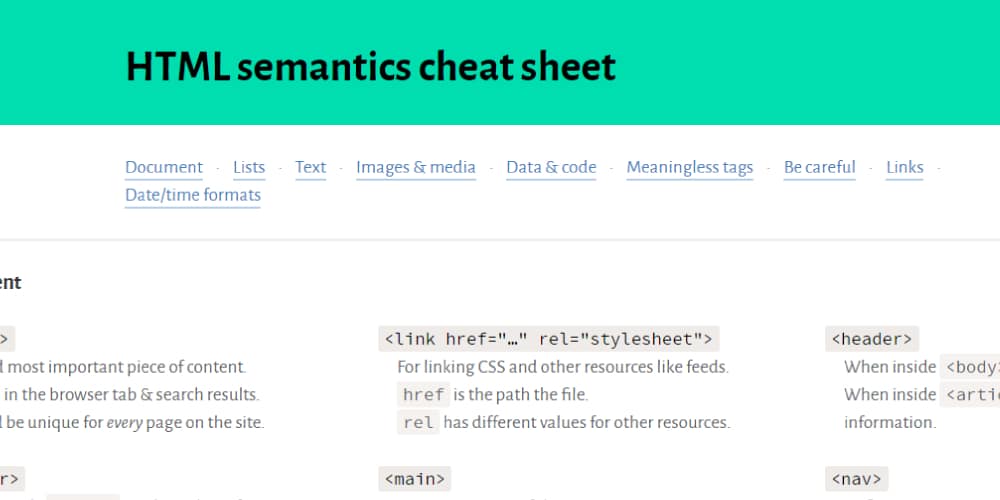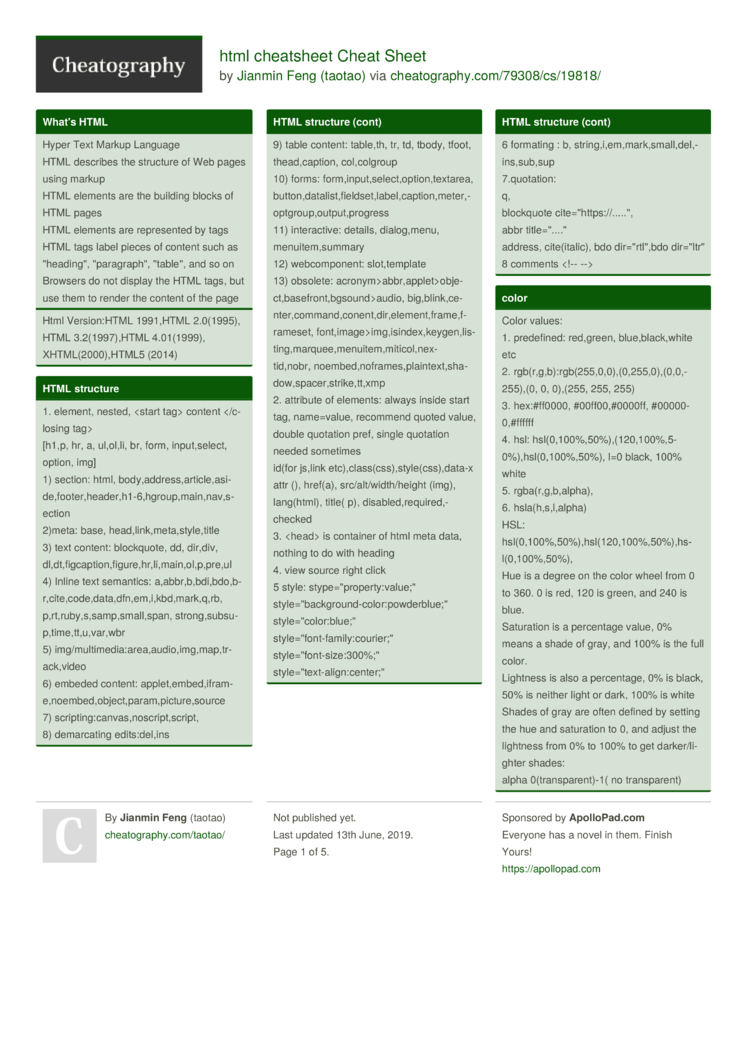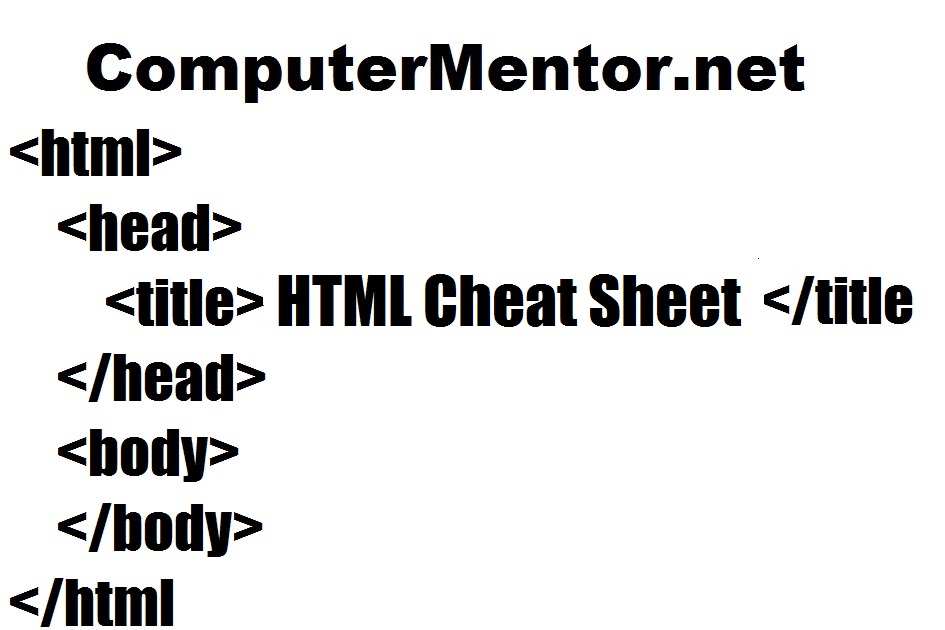An easy-to-use HTML 5 cheat sheet for beginners – 2021 WPKube has prepared an extensive, up-to-date, ultimate cheat sheet on HTML 5— it includes all the tags listed in alphabetical order. We also included the availability of the tag from the previous HTML 4 version for comparison. On the other hand, this cheat sheet also includes a list of event. Continue Reading. HTML Cheat Sheet is used to develop web pages and HTML latest version 5.x has different features and functionalities in its HTML Elements and Form tags. The other different features are HTML local and session storages in the browser. HTML Basics Tables Forms HTML5 Semantic Tags 2. CSS Basics Text Fonts Color Border Margin - Padding Position Pseudo Classes - Elements Flexbox Responsive Design Transform 3. JavaScript Basics Data Types Variables Functions Conditionals Arrays Loops Objects Classes Modules Errors Promises Async Await Requests 4. React Create React App Components JSX. WebsiteSetup.org - Beginner’s HTML Cheat Sheet 6 The HTML element displays its contents styled in a fashion intended to indicate that the.
Semantic elements = elements with a meaning.
What are Semantic Elements?
A semantic element clearly describes its meaning to both the browser and the developer.
Examples of non-semantic elements: <div> and <span> - Tells nothing about its content.
Examples of semantic elements: <form>, <table>, and <article> - Clearly defines its content.
Semantic Elements in HTML
Many web sites contain HTML code like: <div> <div> <div> to indicate navigation, header, and footer.
In HTML there are some semantic elements that can be used to define different parts of a web page:
- <article>
- <aside>
- <details>
- <figcaption>
- <figure>
- <footer>
- <header>
- <main>
- <mark>
- <nav>
- <section>
- <summary>
- <time>
HTML <section> Element
The <section> element defines a section in a document.
According to W3C's HTML documentation: 'A section is a thematic grouping of content, typically with a heading.'
A web page could normally be split into sections for introduction, content, and contact information.
Example
Two sections in a document:
<h1>WWF</h1>
<p>The World Wide Fund for Nature (WWF) is an international organization working on issues regarding the conservation, research and restoration of the environment, formerly named the World Wildlife Fund. WWF was founded in 1961.</p>
</section>
<section>
<h1>WWF's Panda symbol</h1>
<p>The Panda has become the symbol of WWF. The well-known panda logo of WWF originated from a panda named Chi Chi that was transferred from the Beijing Zoo to the London Zoo in the same year of the establishment of WWF.</p>
</section>
HTML <article> Element
The <article> element specifies independent, self-contained content.
An article should make sense on its own, and it should be possible to distribute it independently from the rest of the web site.

Examples of where an <article> element can be used:
- Forum post
- Blog post
- Newspaper article
Example
Three articles with independent, self-contained content:
<h2>Google Chrome</h2>
<p>Google Chrome is a web browser developed by Google, released in 2008. Chrome is the world's most popular web browser today!</p>
</article>
<article>
<h2>Mozilla Firefox</h2>
<p>Mozilla Firefox is an open-source web browser developed by Mozilla. Firefox has been the second most popular web browser since January, 2018.</p>
</article>
<article>
<h2>Microsoft Edge</h2>
<p>Microsoft Edge is a web browser developed by Microsoft, released in 2015. Microsoft Edge replaced Internet Explorer.</p>
</article>
Example 2
Non Semantic Html
Use CSS to style the <article> element:
<head>
<style>
.all-browsers {
margin: 0;
padding: 5px;
background-color: lightgray;
}
.all-browsers > h1, .browser {
margin: 10px;
padding: 5px;
}
.browser {
background: white;
}
.browser > h2, p {
margin: 4px;
font-size: 90%;
}
</style>
</head>
<body>
<article>
<h1>Most Popular Browsers</h1>
<article>
<h2>Google Chrome</h2>
<p>Google Chrome is a web browser developed by Google, released in 2008. Chrome is the world's most popular web browser today!</p>
</article>
<article>
<h2>Mozilla Firefox</h2>
<p>Mozilla Firefox is an open-source web browser developed by Mozilla. Firefox has been the second most popular web browser since January, 2018.</p>
</article>
<article>
<h2>Microsoft Edge</h2>
<p>Microsoft Edge is a web browser developed by Microsoft, released in 2015. Microsoft Edge replaced Internet Explorer.</p>
</article>
</article>
</body>
</html>
Nesting <article> in <section> or Vice Versa?
The <article> element specifies independent, self-contained content.
The <section> element defines section in a document.
Can we use the definitions to decide how to nest those elements? No, we cannot!
So, you will find HTML pages with <section> elements containing <article> elements, and <article> elements containing <section> elements.
HTML <header> Element
The <header> element represents a container for introductory content or a set of navigational links.
A <header> element typically contains:
- one or more heading elements (<h1> - <h6>)
- logo or icon
- authorship information
Note: You can have several <header> elements in one HTML document. However, <header> cannot be placed within a <footer>, <address> or another <header> element.
Example
A header for an <article>:
<header>
<h1>What Does WWF Do?</h1>
<p>WWF's mission:</p>
</header>
<p>WWF's mission is to stop the degradation of our planet's natural environment,
and build a future in which humans live in harmony with nature.</p>
</article>
HTML <footer> Element

The <footer> element defines a footer for a document or section.
A <footer> element typically contains:
- authorship information
- copyright information
- contact information
- sitemap
- back to top links
- related documents
You can have several <footer> elements in one document.
Example
A footer section in a document:
<p>Author: Hege Refsnes</p>
<p><a href='mailto:hege@example.com'>hege@example.com</a></p>
</footer>
HTML <nav> Element
The <nav> element defines a set of navigation links.
Notice that NOT all links of a document should be inside a <nav> element. The <nav> element is intended only for major block of navigation links.
Browsers, such as screen readers for disabled users, can use this element to determine whether to omit the initial rendering of this content.
Example
A set of navigation links:
Define Semantic Html
<a href='/html/'>HTML</a> |
<a href='/css/'>CSS</a> |
<a href='/js/'>JavaScript</a> |
<a href='/jquery/'>jQuery</a>
</nav>
HTML <aside> Element
The <aside> element defines some content aside from the content it is placed in (like a sidebar).
The <aside> content should be indirectly related to the surrounding content.
Example
Display some content aside from the content it is placed in:
<aside>
<h4>Epcot Center</h4>
<p>Epcot is a theme park at Walt Disney World Resort featuring exciting attractions, international pavilions, award-winning fireworks and seasonal special events.</p>
</aside>

Example 2
Use CSS to style the <aside> element:
<head>
<style>
aside {
width: 30%;
padding-left: 15px;
margin-left: 15px;
float: right;
font-style: italic;
background-color: lightgray;
}
</style>
</head>
<body>
<p>My family and I visited The Epcot center this summer. The weather was nice, and Epcot was amazing! I had a great summer together with my family!</p>
<aside>
<p>The Epcot center is a theme park at Walt Disney World Resort featuring exciting attractions, international pavilions, award-winning fireworks and seasonal special events.</p>
</aside>
<p>My family and I visited The Epcot center this summer. The weather was nice, and Epcot was amazing! I had a great summer together with my family!</p>
<p>My family and I visited The Epcot center this summer. The weather was nice, and Epcot was amazing! I had a great summer together with my family!</p>
</body>
</html>
HTML <figure> and <figcaption> Elements
The <figure> tag specifies self-contained content, like illustrations, diagrams, photos, code listings, etc.
The <figcaption> tag defines a caption for a <figure> element. The <figcaption> element can be placed as the first or as the last child of a <figure> element.
The <img> element defines the actual image/illustration.
Example
<img src='pic_trulli.jpg' alt='Trulli'>
<figcaption>Fig1. - Trulli, Puglia, Italy.</figcaption>
</figure>
Why Semantic Elements?
According to the W3C: 'A semantic Web allows data to be shared and reused across applications, enterprises, and communities.'
Semantic Elements in HTML
Below is a list of some of the semantic elements in HTML.
| Tag | Description |
|---|---|
| <article> | Defines independent, self-contained content |
| <aside> | Defines content aside from the page content |
| <details> | Defines additional details that the user can view or hide |
| <figcaption> | Defines a caption for a <figure> element |
| <figure> | Specifies self-contained content, like illustrations, diagrams, photos, code listings, etc. |
| <footer> | Defines a footer for a document or section |
| <header> | Specifies a header for a document or section |
| <main> | Specifies the main content of a document |
| <mark> | Defines marked/highlighted text |
| <nav> | Defines navigation links |
| <section> | Defines a section in a document |
| <summary> | Defines a visible heading for a <details> element |
| <time> | Defines a date/time |
For a complete list of all available HTML tags, visit our HTML Tag Reference.
An easy-to-use HTML 5 cheat sheet for beginners – 2021
WPKube has prepared an extensive, up-to-date, ultimate cheat sheet on HTML 5— it includes all the tags listed in alphabetical order. We also included the availability of the tag from the previous HTML 4 version for comparison. On the other hand, this cheat sheet also includes a list of event attributes supported in both HTML 4 and 5 versions, for cross-referencing. We also compiled the different desktop and mobile support and compatibility specifications for HTML 5 on different browsers.
There are new interoperable implementations made possible through HTML 5. Now, HTML 5 has the capability to extend, rationalize, and even improve markup available for web documents. Moreover, it can handle complex web applications through new markups and by handling Application Programming Interfaces, commonly known as API. HTML 5 is also mobile-friendly; its features were designed with cross-platform integrations in mind.
We hope that with this ultimate cheat sheet, you’d be able to recall or re-master the different markups that has already been updated from HTML 4 to HTML 5. HTML 5 can help designers use cleaner markups that are consistent and uniform, create elegant forms, and work with rich media elements.
Want to get a copy of the cheat sheet?
If you want to download the JPEG version of the cheat sheet – click here
If you want to download the PDF version of the cheat sheet – get it here
Embed This Infographic On Your Site (copy code below):

Html Semantic Cheat Sheet Free
